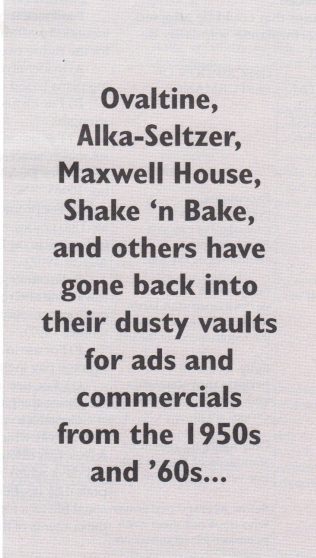Muhamed Muneer
Are the ads of yesterday, selling the products of today?
THERE WAS A TIME WHEN A if marketer who suggested running that ad we produced 20 years ago would have quickly been escorted from the room, not the business. But this is a time of anything-goes creative work. The music is loud, the models are nude, and some ads are hot enough to become stories on the evening news. Many of the ads even look like the evening news- or music videos.
Amid the clutter, the challenge to stand out is even more intense in the face of soaring production costs and an increasingly fragmented media. The challenge is just as great to keep an old, established brand alive against an avalanche of new and aggressive competitors.
In the quest for such standout, break-through appeal, marketers and creative directors are looking back- wards.
Ovaltine, Alka-Seltzer, Maxwell House, Shake ‘n Bake, and others have gone back into their dusty vaults for ads and commercials from the 1950s and ’60s, trying to tap the warm, nostalgic feeling they hope the public has for, if not their actual products, then their old commercials.
But do these retro ads sell or merely entertain today’s sophisticated audiences? This is, after all, the audience that has embraced the cable channels Nick at Nite and TVLand, where programming is exclusively reruns of vintage sitcoms – with the original commercials intact and ratings are respectable.
Nostalgic fling
The idea of taking a successful concept from the past and exploiting it in the future is hardly new, of course. A basic ingredient in building brand loyalty is showing consistency
over time. Certainly every generation also has its fling with nostalgia, whether it’s the big band music of Glenn or the tag line Just like mother used to make.
What’s different this time around is the use of actual archival ads. This is not the Pepperidge Farm recreation of the good old days of horse-driven delivery wagons or the high-tech, computer-generated casting of John Wayne in a beer commercial or Humphrey Bogart having a diet Coke with Elton John.

Dustin’ off the oldies
This is dusting off the old black and white film for presentation so a whole new generation can hear the original, and most memorable, Crest toothpaste line: ‘Look, Mom! No cavities! The little girl, who may or may not be a future Scarlett O’Hara, listens while her mom expounds on the convenience of cooking chicken with Shake ‘n Bake and drawls, ‘And I helped.”
Maxwell House coffee brought back both the old film of a pot of coffee brewing and its “Percolator” theme song, which actually became a hit record after its commercial introduction. A good strategy, all agreed; a breakthrough. People saw the commercial, liked the music, bought the record, and every time they played it or heard it on the radio, they would think of Maxwell House coffee.
The beloved, long-retired, pre- Toy Story, distant cousin of Gumpy, speedy Alka-Seltzer, returned to bring old life to new cases of indigestion.
Is this simply wisely building on a well-established base? Is this exploitation with reverence and affection for consumers’ cherished childhood memories? Is it just cheaper than doing a whole new ad or TV spot, or easier than coming up with a whole new idea?
The only question that really matters: Does it work? The answer is a definite sort of. Nostalgia is as strong a device in marketing as it is in entertainment. Whether it’s the Time-Life Treasury of Old Songs or the antique auto show at the fairgrounds, people will stop to look at a page of history if it is an interesting page, well-presented. So, as an attention-getting device, using decades-old photos, films, fashions, and props taps the entertainment button.
Future not in the past
But getting attention and being entertaining are not, in themselves, what sells. People will watch a classic film on TV, but they won’t pay today’s movie prices to see it on the big screen at the local theater. Similarly, the old ads will be noticed, draw a smile and a nod of recognition, but the industry that virtually grew up around the phrase ‘new and improved will not find its future in the words ‘remember when.’
This type of retro marketing is, by design, highly exclusionary. In the examples noted, the messages seem to be aimed at baby boomers. Generation X and preteens don’t remember Ovaltine as their parents do. Their parents might indeed ‘remember how much you loved it,’ but most of them have pretty much given up drinking chocolate milk.
Marketers seek to position products as the latest advancement’ or as ‘state- of-the-art. The very last type of image a product or company wants is that of ‘yesterday’s brand.’ Why then think that today’s market will respond with any. thing more than amusement to yester- day’s ad? Vintage clothing and oldies CDs may have found a market, but it is a niche market, right up there with stamp collecting and US soccer; it’s not for everybody. The advertisers using the old spots are looking for a broad audience with al message designed to appeal to a limited few. for our brand? Check out these three guidelines: For retro marketing to be even reasonably effective for the duration of a campaign, the original campaign must qualify as a classic. Very few do.
Astute marketers know that memories are treasures, but even Betty Crocker, patron saint of the world’s best-selling cake mixes, periodically needs a new hairdo, a face-lift, and a little more sugar.
Can we make retro marketing work for our brand? Check out these three guidelines:
For retro marketing to be even reasonably effective for the duration of a campaign, the original campaign must qualify as a classic. Very few do.
Additionally, the product must have value at least equal to current competitors, and the brand should not have been invisible for so long that the retro campaign looks like merely a continuation of the last word people heard about the brand. Have fun. Your campaign might have been a hit, but it’s not sacred. Treat the reframing of your ad with good humor. Emphasize the benefits and value of the product to today’s consumer.



